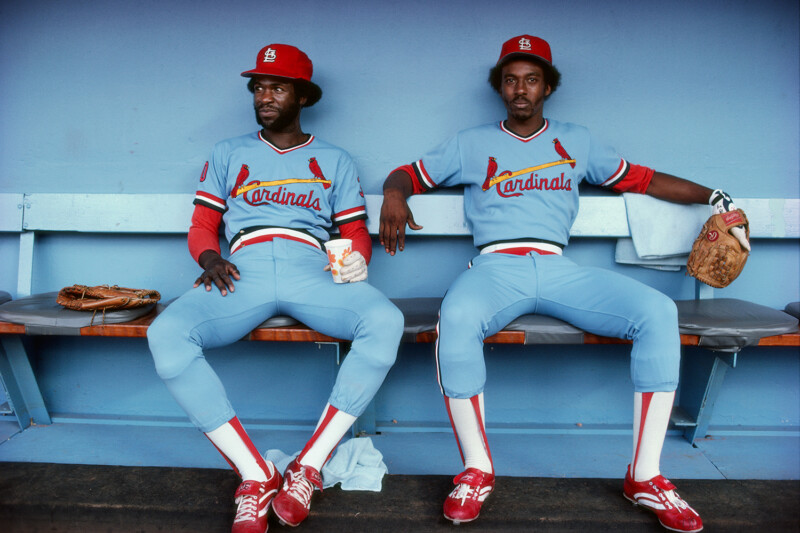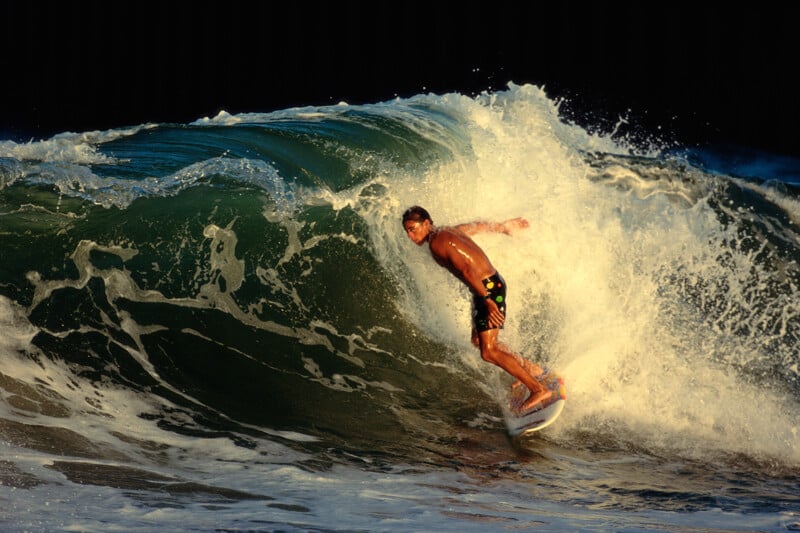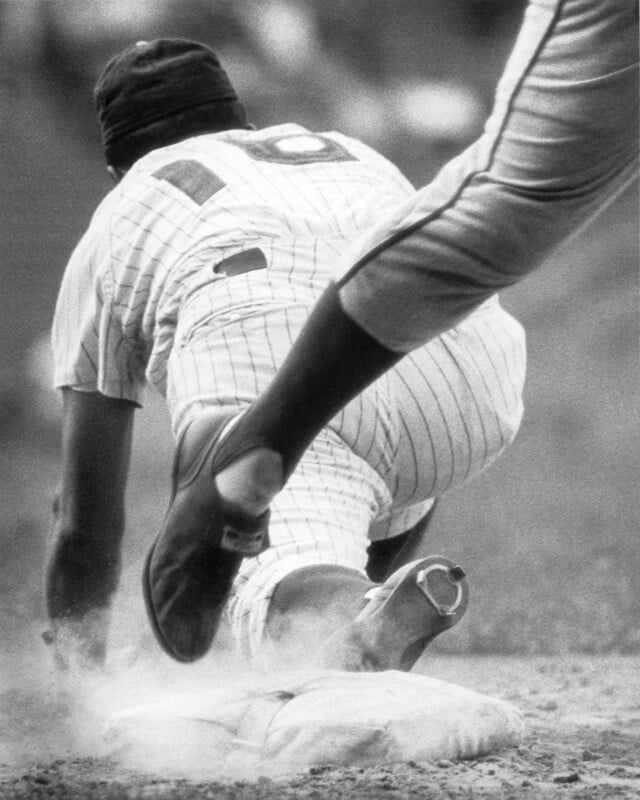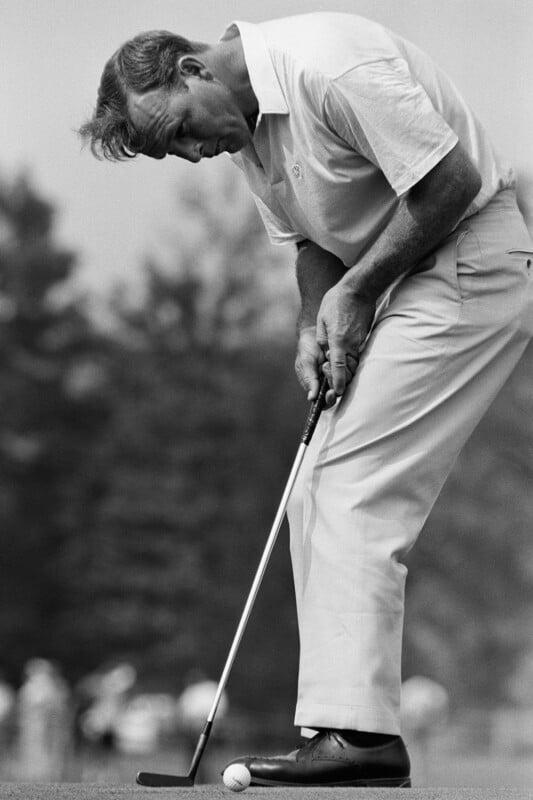Walter Iooss: Framing the Sports Photo
![]()
Walter Iooss Jr.’s photos have graced 300 Sports Illustrated covers in a career spanning six decades. He has captured iconic images of every athlete, including Muhammad Ali, Michael Jordan, Pele, Cristiano Ronaldo, Michael Phelps, Tiger Woods, Serena Williams, and Kobe Bryant.
Iooss (pronounced Yoce, which rhymes with dose) has photographed the first 52 Super Bowls and spent two years doing a photodocumentary, Shooting for the Gold, with US athletes as they prepared for the 1984 Los Angeles Olympics. He has also captured athletes in Nike, Adidas, Coca-Cola, and more campaigns.

In 2021, Forbes compared the photographer to a master painter of old, saying: “His masterful manipulation of light and shadow evokes Rembrandt’s chiaroscuro, or ‘light and dark’ to reveal contrasts of detail.”
First Paid Assignment from Sports Illustrated at Age 17

Iooss’ father, a jazz musician, was interested in photography.
“One of the things my father and I shared was a love for photography and sports,” says Iooss, as he joined PetaPixel for a conversation from Key Biscayne, Florida. “[When] my parents got divorced, I would see my father on Sundays, and [he would take me to] football games, basketball games, and it started when I was 15. I was just consumed with it and took an accelerated fundamentals course at The Germain School of Photography in lower Manhattan and gave up my beloved stickball for the summer.”

Iooss’s father let him shoot with his Asahi Pentax (probably a Spotmatic) with an Asahi Super-TAKUMAR 300mm f/4 lens. Young Iooss took three or four frames, and when he processed the roll of film and held up the frames, everyone said that his future was unlocked from that moment on — “that’s what I was going to do.”
“I called up Sports Illustrated when I was 16,” remembers Iooss. “I always loved looking at the magazine and was transfixed by the imagery. I picked up the phone in the kitchen and asked for a gentleman called George Bloodgood, an assistant picture editor. Those days, people answered their phones, and I told him, ‘I am Walter, yes, I have a portfolio. Can I come and show it?’
“He knew I was a kid, and I remember he said, ‘You have any nudes in it?’ He invited me over to his office and started giving me spec assignments. He said, ‘Go to Philly. Your father will take you. Photograph this specific player. We’ll give you the film, process it, and critique it. Then [after 5-6 tries], he gave me my first assignment.”

The assignment was $100 a day, which was a lot of money then — it’s the equivalent of around $1,040 in today’s money — and that was the beginning. By 19, he was “all over the place.”

Shooting 300 Covers for Sports Illustrated
Iooss started shooting covers for SI when he was 20 and has amassed over 300 of them in his lifetime. In fact, in some years, he had 10 to 12 covers.

Iooss favorite cover image is The Catch, of Dwight Clark making a leaping grab to complete a touchdown pass from quarterback Joe Montana with seconds left in the game enabling the 49ers to defeat the Cowboys 28–27. This is also regarded as one of the greatest plays in NFL history.
“That’s one of my most well-known images,” says Iooss. “I spent that season covering the Dallas Cowboys from camp in Thousand Oaks, California, in July through the Candlestick Park in San Francisco. On that January day when Joe Montana rolled right with seconds left and threw a ball that only one man on earth could catch, Dwight Clark.
“We shipped the film out to New York. I’m not sure how it got there, and next week Sports Illustrated cropped the picture with the headline The Catch. It’s arguably the most famous football picture.”

With film photography, you never knew whether you had captured the ball and player in the perfect position. Also, this was shot on slide film where the exposure was much more critical than color negative.
“I didn’t know I had it. I had practiced taking that type of picture. This is not like I suddenly took one picture. I’ve been working on this for years because I love pass receivers in pro football. I always had a normal lens [50mm on a Canon F1]…if someone was 15 feet from me, I was ready and pre-focused.

“You just have to believe wherever you’re going to go late in the game is the right place, and I had a sense for it. I was in the right place many times, and I watched Montana and photographed him rolling right as he released the ball. I saw something coming in from my right side, and The Catch was born. At the perfect time (of the exposure), his fingers weren’t even completely embracing the ball.”
Sports Illustrated sometimes chartered a Learjet just to ship exposed film back to the office, and it went from chopper to Learjet to limo in its journey.


“After Super Bowl One, Neil Leifer and, I think, Jim Drake and I flew back on a jet which had to refuel at the halfway spot in America called Grand Island, Nebraska. So, you get off the plane for 15 minutes, they refuel the jet, and then go on to Kennedy or Teterboro Airport in New Jersey, wherever we landed, and you get a limo or a chopper.
“One of the Super Bowl [films] were choppered out of Detroit to the Learjet. I used to take the film back from Wimbledon on the Concord [supersonic plane taking three hrs. from London to New York]. I used to leave with the film after Wimbledon on Monday morning. You arrived before you left because of the time change. If I left on a 10 a.m. or noon flight, I’d be at Kennedy [New York Airport] at 10 in the morning and hand the film off to be processed. They would edit it and put it in the magazine, which would come out Thursday.”


During his active shooting days for SI, Iooss was out of the house for half of the year every year. His wife said that he was a human FedEx package — SI just pastes a label on him and sends him off. She got tired of answering the question, “Where is Walter?” so she made up a T-shirt with the same question in the front, and on the reverse were the answers: Los Angeles, San Francisco, Philadelphia, Atlanta, New York.
Michael Jordan on Iooss: “He’s Quick, and He’s Good”
Iooss says that Michael Jordan was the most fun to photograph.

“First of all, you can’t take a bad picture of Michael Jordan, and I had incredible access to one of the most famous athletes in the sport’s history,” remembers Iooss. “We did a book together and a second book, and I did a lot of his advertising shoots all through the 90s, and you know he requested me because his greatest quote for me was ‘He’s quick, and he’s good.’
“You know, quick’s one thing, but if you’re doing a shitty job, they are gonna get someone else, absolutely.”

Iooss has three photos that are his favorite, and two of them include Michael Jordan.
“Maybe three [favorites]: the Blue Dunk with Michael Jordan, my kids in Cuba playing stickball with ten kids on a corner, and the Jordan slam dunk.

“Blue Dunk. There’s a picture everything about which was created. Michael had a children’s camp in Lisle, Illinois, outside of Chicago. I met him the day before, and I shot a portrait of him which ended up being a cover, and the next day I had this idea [for a photo.] I painted a huge parking lot, one side red and the other blue.”
Iooss had a visual of a high-angle shot of Jordan dunking with his sharp shadow from sunlight low on the horizon.



“And to create this look with the shadow, you can’t have a stationary basket unless it happened to be in the perfect position [meaning it had to be moved around.] There were no NBA baskets in Chicago, so we had a basket driven in from St Louis, and it was important you could have a real basket, which could be raised or lowered as Michael didn’t want to jump full blast all the time.
“I had a cherry picker so I could get above it, but I didn’t know what color uniform he would wear until he showed up. So, if he wore his red uniform, we would go blue [court], or red if he wore the blue uniform.
“It had to take place between 2-3 p.m. for the length of the shadow [to be correct]. I couldn’t get any clouds. I had the perfect day, and the blue dunk [he wore red] was created.
“It was shot on the Canon F-1 High-Speed Motor Drive Camera, which could shoot film at 14 fps [not a typo!].”

“My kids in Cuba playing stickball with ten kids on a corner was a Renaissance for me. It was like bringing back my childhood. I photographed a lot of kids’ sports throughout the world. The beauty in sports is when you play it, nothing else exists. If you’re having problems, once a pitch is delivered to you and you swing at it, nothing’s happening in the world.
“It’s like you take a jump shot and you wait for the sound of the swish, the world stands still, and that’s one of the beauties of sport. It’s feeling the ball and the action and the movement. I’ve always been possessed, even as a kid, and tried to utilize it, photographing the kids in Cuba, Bangkok, Brazil, and where I grew up. I photographed my little league team when I was like 21.”

Iooss’s third favorite photo is of Michael Jordan dunking. He was just not getting the shot till Jordan helped him with a positioning tip that helped him clinch the winning image.
“The slam dunk. I got two Jordans in there [his three favorite photos.] The slam dunk in 1988, one frame, perfect.
“What I learned was in the slam dunk contest in 1987 in Seattle, which I lit [with strobes in the catwalk]. It [the setting] took a great picture, but it wasn’t Michael Jordan. I looked at the pictures, and Jordan’s face was always blocked. You didn’t know if he was coming from behind.
“So, in 1988, I went to the slam dunk contest in Chicago. I had strobes up in the Chicago Arena and arrived very early on a freezing day. Michael comes in, and he’s sitting in the front row, and just like people setting up stuff, I started to talk about it.
‘This is either the stupidest question I’ve ever asked or the smartest. If you can tell me which way you’re going to go’…because everything with Michael’s a game. He said, ‘Sure.’ I said, ‘How are you going to tell me?’ He said, ‘You watch; I’ll point on my knee.’ I said, ‘You’re gonna remember this?’ ‘You watch,’ he says.
“So, I’m sitting under the basket. I look over. He pats his knee and goes like that, so that means I have to go to one side so I can see his face. He ran from one end of the court to the other with the famous slam dunk. I was right in the basket with my Hasselblad, and he fell into my lap, which was sort of exciting for me but not for him.
“So, on the last dunk, I was in the same position, he looked down the court at me, and he goes [gestures] ‘slide over baby,’ and that was it, slam dunk 88, which ran on the cover [sometime later.]
“I firmly believe in it, you know, you can ask anyone anything. They might think you are crazy, and you may get a No, not doing that, or you might get a Yes.”




The Cameras, Films, and Lights for Sports Photography
Iooss started his photography as a teenager on his father’s Pentax. He then moved up to the Nikon F and then the F2.
“I used Nikons for years, and then I got involved with Canon in the late 70s. I have been a Canon Explorer of Light for a long, long time since they started. I have kept all these earlier cameras in our house in Montauk [NY] — many feet of cameras. I’ve got almost all the cameras I used. I still have the original Pentax but not the 300mm. I don’t know what happened to that, but I have my standard lens.”



“My father and I would go to Madison Square Gardens,” Iooss continues. “I would use a film called Isopan Record [Agfa Isopan Record (640 ASA (ISO)]. It was dark. That place was a dungeon. Isopan was a high-speed film [at that time].”
Iooss’s main film was Kodak Tri-X, and he would also push-process it right from his beginning days.
“My first color film was Kodachrome, ASA (ISO) 10, right 10. And then, you know, Ektachrome came in. It was 160 ISO or something. Everything I had, which sounds old-fashioned now, was the best in the world. ISO 2000 now doesn’t mean anything.”



In 1982, Fujifilm commissioned Iooss to do a photodocumentary of athletes trying for the 1984 Summer Olympics in Los Angeles.
Most of his later film work is shot on Fujifilm.
“Fujichrome very well could have been the best high-speed color film ever invented,” he says.


Iooss set up strobes in the catwalk of big arenas, as that was the favored technique of SI.
“Yes, we used to do that. I had to set all those strobes [Speedotrons] up there, which was a nightmare, but you know you can create beautiful light, and now the arenas are so illuminated I don’t know if you necessarily need them. If you turn off one light or two lights, you can create some stunning effects, which I started doing back in the 80s.”



“I did it with Jordan in many places,” the photographer says. “I’d take one light and just aim at the crowd behind him and then one light over the basket. You used to be able to put them up on the mezzanine level in Philadelphia in the late 60s, so the light was much lower, and it had a much better angle. Everyone was smoking, so the arena had this look that no longer exists. The lights now are almost straight above.”
Iooss often used a Hasselblad for the flash shots as the flash synchronized up to 1/500 sec on the leaf shutter (located between lens elements near the aperture blades) instead of 35mm, where it was slower.







“The flash sync speed was 125th of a second, then it went to 1/160th and then 1/250th where you still get an edge, but if you go 500th of a second on a Blad [Hasselblad], no ghosting,” says Iooss. “You can’t use 120 when they want something repetitive that needs a motor drive. If you’re doing anything in the studio, it was always 6×7 and the Mamiya RZ67 with Winder II motor drive. I also had the Mamiya 7 [a 6x7cm medium-format rangefinder camera system with interchangeable lenses.] I also shot the 20 x 24 inch Polaroid for years.
“I had this Canon F-1 High-Speed Motor Drive camera that took 14 frames per second [introduced for the 1984 Winter Olympics. It had two huge battery packs attached to the bottom and would chew through a 36-exposure roll of film in just 2.57 seconds. The lens had to remain stopped down for the entire burst and had a fixed translucent pellicle mirror.]
“I remember when I went to a football game with this, all the pros on the sidelines had cameras shooting at five frames a second. When I let this thing go, I looked at the other demoralized photographers because if I was in focus, you couldn’t beat me.”
When autofocus came around, Iooss was happy to use it.
“You’re damn right, I did [use autofocus]. It saved a lot of photographers’ lives. Autofocus now is so great it’s ridiculous. The good action photographer at Sports Illustrated then could focus the manual 600mm. You became very adept at using it.
“I could change the balance a little with the camera, and you just became [an expert]. It’s like practicing the piano. You had a knack for follow focus which wasn’t that easy, and then when autofocus came in, you had to be very careful of what was in your foreground [lest it locked in on that instead of the subject].
“This is the camera I use today [he holds up an iPhone], very good. These cameras are remarkable, and you always have a camera with you. Most of the time, nothing’s happening, but if something remarkable happens, you’ve got it.”
More Freedom in Editorial Than Advertising
Besides editorial, Iooss did commercial shoots for Nike, Adidas, Coca-Cola, Gatorade, Fujifilm, Eastman Kodak, Camel, and Marlboro.
“I mean, the advertising business was so lucrative that at one point, I would stay down in Key Biscayne and work for Pepsi, and the next day I worked for Coca-Cola. So, we’d have to hide everything in the [hotel] room, all the slides, and then you work for Adidas one day and Puma the next.”



“Editorially, there’s more freedom than advertising because they usually have a concept in advertising. Art directors draw up what they want for the ad in advance. There were a lot of good ads that restricted your creativity. They hire you for what you do, and then sometimes, when they get you there, they don’t want you to do exactly what you do. But in the end, you’ve got to change that.
“I was on a set in a studio one day, and I took the first Polaroid and looked at it, and they’re all hovering over it and said, ‘Can we try something different?’ I said, ‘I just started. I’m not even shooting film.
“Once the screen came in, people are like over your back. Everyone’s staring at the screen tethered. I didn’t like that either.”
Sports Illustrated’s Swimsuit Issues
Iooss has been lucky to photograph some of the most beautiful women in the world, and that too in the most beautiful locations.

“The swimsuit issue was very special back then. I shot 25 or something somewhere up there. They were great adventures. Beyond just the beautiful women, where you went to Seychelles, Fiji, I mean, some of the most fabulous places in the world. You woke up every day with a chance in the morning and evening to take a great picture. You don’t have that chance every day, but on the swimsuit issue, you did.
“I used fill flash, and I use incandescent lighting. I’ve used every type of light. The crew grew and grew and grew. I only had one assistant, and then we had a digital guy and hair and makeup. You had the SI video crew. Then you had the editor, the assistant editor, and maybe another assistant editor. So, what grew from four or five people on the road became an extravaganza.
“I had a motor drive I used. The best years were with the Mamiya RZ67, although a lot of 35mm initially.
“I came in 1973 [swimsuit issue first published in 1964]. The best part of the swimsuit issue was when it was at its peak popularity in the 90s. Once a year on Sunday at prime time, when people watch Network TV like ABC, they’d have the swimsuit issue, and I was the male lead for a few years.
“All the athletes would watch the show as it was about hot girls. In the locker rooms, no one would pay attention to me, but then suddenly, ‘Hey, are you the photographer who shot the swimsuit girls?’ I said, ‘Yeah.’ ‘Oh, come over here,’ and then it’s like, can I hook them up and ‘I can’t hook you up.’
“Christy Brinkley [appeared on an unprecedented three consecutive covers in 1979, 1980, and 1981] was so beautiful, it was Cancun, her first shoot, and I remember I shot 23 rolls of film on basically one pose because I didn’t want to stop. It was just like she radiated personality and beauty in her prime.”
Photography for Work, Music for the Heart
Iooss is known for his sports photography, but few of his fans are aware that he is very passionate about music as well – and, maybe, even more!
“I always believed that if my parents had stayed together, I would have been in the music business,” reflects Iooss. “But I’m not complaining about what happened.
“I don’t know [what I would have done], maybe piano. I mean, I sang in choirs. I could sing but not enough for jazz. I’m sure I would have gone into R&B.
“I can’t live without music. I could, I think, live without photography quicker than no music.”
You can see more of Walter Iooss’ work on his website and Instagram.
About the author: Phil Mistry is a photographer and teacher based in Atlanta, GA. He started one of the first digital camera classes in New York City at The International Center of Photography in the 90s. He was the director and teacher for Sony/Popular Photography magazine’s Digital Days Workshops. You can reach him here.
Image credits: All photos © Walter Iooos Jr., Courtesy Bruce Silverstein Gallery, NY.